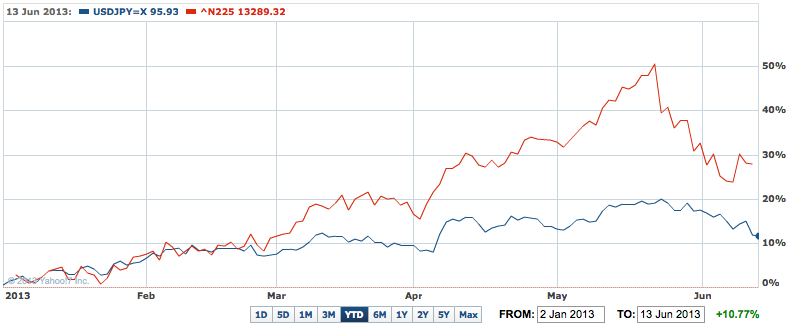Get used to it – the rising volatility we have seen in the past three weeks will continue, especially for much of next week – the US is recovering and that, plus the stuttering attempts to reflate the moribund Japanese economy, are going to rattle confidence levels for investors around the world.
The impact of those two factors was seen in new growth estimates from the World Bank which showed higher growth forecast for both Japan and the US this year, and weaker growth for China and other emerging economies and the eurozone.
The better growth prospects for the US and Japan have produced a rise in market interest rates – around 0.60% in the US for the 10 year bond, which is the key rate indicator for the world. In Japan 10 year bond yields have risen by around 0.50% to just under 0.90% since early April when the reflation attempt was first detailed.
At the same time real US interest rates (that’s after inflation), have become positive in the past few days for the first time in 18 months – an indication of the growth strength of the US economy, but also falling inflation.
These developments are rattling global markets as investors increasingly speculate on the timing of the ending of the Fed’s latest multi-billion easing. Commodity economies and currencies, such as Australia’s and so-called emerging economies and currencies (such as China, Brazil, India, Indonesia etc) are being singled out by nervy investors. China’s slowing growth is also pressuring commodity prices lower.
Adding to the pressures is the June meeting of the US Federal reserve next Tuesday and Wednesday nights (our time). If the Fed and chairman Ben Bernanke indicates a firmer date for the easing of the central bank’s spending, markets will be rattled, even though a growing number of banks and others want an end to the spending and higher interest rates to improve their profitability.
These complex reasons are why our market has sold off, while emerging markets are down sharply as well (Brazil, South Africa and India) and currencies are weakening. We in Australia are helpless in the face of these offshore developments. Nothing we can do or say can ease the pressures, which are streaming in daily from Japan and the US.
Developed markets are shaky – Japan, Australia, some of Europe and even Wall Street; the yen (after its strong rise since late last year) has risen sharply against the dollar, which in turn has confused traders in currencies such as the Aussie dollar which is under pressure finally from weakening commodity prices.
Overnight thought, some European rose after an early fall in the wake of the plunges across Asia, and the US market ended in the green after some reassuring retail sales figures for May were released.
The Aussie dollar rebounded and ended around 96 US cents as its recent volatility continued. Gold fell by more than $US10 an ounce, oil rose. These are all short term reactions.
If anything local factors, such as yesterday’s jobs report, last week’s first quarter GDP figures and Reserve Bank interest rate decisions are second tier factors when it comes to the reasons for the slide in May and June here. The pressures are all from offshore.
Take yesterday. Markets in Asia shook when, after Wall Street rose and then fell sharply, the yen rose sharply against the greenback and the Tokyo stockmarket plunged by more than 6% in a couple of hours of early trading. Japan is now in bear market territory, down 22% from its high in May (a bear market is a fall of 20% from its most recent peak).
That was due to the yen rising to a two month high against the greenback – which goes against the way the currency moved from November (when the reflation plans first appeared) and mid-April.
Leading the deep losses suffered across most of the region, the Nikkei Stock Average plummeted 6.4% to 12,4456 – dropping back under the 13,000-point level it had recaptured in early April but briefly lost earlier this month.
Nikkei / USDJPY YTD – Japan’s Instability Driving Markets Mad

China’s Shanghai Composite tumbled 3.3% as the markets reopened for the first time this week after a string of holidays, giving investors a chance to react to a string of downbeat economic data released over the weekend, including the poor monthly trade, loan and production data.
Hong Kong’s Hang Seng Index lost heavily as well and dropped 2.2%, while South Korea’s Kospi lost 1.4%. Singapore fell 1.5% and the market is now in bear territory. The Manila market slumped 5.5%.
The Thai market fell more than 4% and the Indonesian market was off nearly 2% after the central bank intervened on Wednesday and yesterday to support the rupiah after it plunged.
Australia’s ASX 200 fell 66 points or more than 1.2% at one stage to dip into correction territory – having dropped more than 10% from the highs reached in May.
The ASX 200 bounced in late afternoon trading to halve the losses and close off 0.6%. That left in correction territory – more than 10% from its May peak.
That was despite a small rise in the value of the Aussie dollar after the better than expected May jobs figures were released. At one stage yesterday all the gains for the Australian market had been wiped out.
Not helping sentiment was news that the World Bank had lowered its global economic-growth forecast to 2.2% this year, down from a 2.4% projection issued in January and below last year’s estimated 2.3% growth.
In its half yearly Global Economic Prospects report, the bank also cut its expectations for growth in China (7.7%, down from 8.4%). Forecasts for Brazil and India were also dropped, as was the forecast for the eurozone, which the bank now sees contracting by 0.6% against a January forecast of 0.1%. Growth in the US was lifted to 2% from the previous estimate of 1.9%. Growth in Japan is now estimated at 1.4%, up from 0.8%.
It was the third Thursday in the past four that violent swings on the Tokyo stockmarket (which are being driven by rising yields on Japanese bonds, which is worrying investors and generating big capital losses) have shaken markets across the region and the rest of the world – Australia included. The only exception was last week when the Tokyo market suffered a big fall on Friday.
Driving this volatility is the expectation that the US Federal Reserve will start easing back on its huge spending program of $US85 billion a month in bonds and mortgage securities. As it has become clear that the US economy is recovering nicely, so the speculation and market volatility has risen about when the Fed will start easing back on that spending (but not stopping it).
With the Fed’s main monetary policy group holding a two-day meeting next Tuesday and Wednesday, with new economic and jobs and inflation forecasts to be released plus a post meeting press conference with chairman Ben Bernanke, market conditions will get a bit rocky Friday and next week until Thursday at the earliest. Big swings – rises and mostly falls can be expected.
The return of volatility to markets can be traced to May 22, when Bernanke said the central bank could cut back on its monetary stimulus if the labor market shows “sustainable improvement”. Before that the markets had months of reasonably calm conditions, except for the surge in the Tokyo market as the yen fell sharply against most other currencies, led by the US dollar.
But that sentiment started turning around the same time as investors if the rise in the Nikkei and the fall in the yen had gone just about as far as they can without supporting evidence from economic data and more action from the Government.The lack of any further easing action from the Bank of Japan after this week’s meeting also worried investors.
Some recent data has suggested the economy is doing better and the government has started fleshing out policies, but nothing will really happen until the Japanese Upper House elections next month.
If the government wins strongly in that poll, it will have more freedom to make some major policies move on investment and reforming markets. This means volatility triggered by events in Japan will continue to bedevil the Aussie stock market.
Late update: The market rout that was developed in Asia yesterday and spread into Europe last night was halted this morning by a story on the Wall Street Journal website that left markets in no doubt that the Fed was not looking to bring forward any move to slow its current of easing or end it at next week’s meeting
And, with the Fed meeting for two days next week, fears grew that the central bank would announce a slowing in the spending (which amounts to a small tightening in monetary policy). Those fears proved too much and we saw a very disorderly day or so of trading this week culminating with the slide across Asia.
And then Wall Street Journal story appeared on the paper’s website around 3.39 pm, New York time, and a weak rebound was turned into a 180 point advance on the Dow in minutes and the yield on 10 year bonds fell to 2.15% from close to 2.20% in early trading.
That also saw the US dollar slide, with the Aussie dollar jumping 2 US cents to close to 96.50 US cents as traders and our market was poised to jump by more than 1% this morning. The Tokyo market was also up in advance futures trading. Gold halved its losses and oil prices also rose in early Asian trading.













